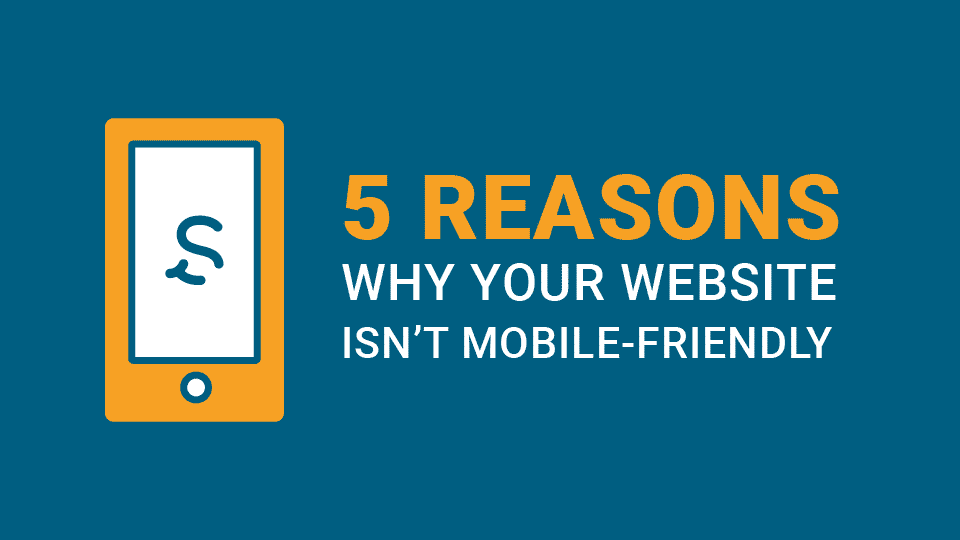5 Reasons Why Your Website Isn’t Mobile-Friendly

Why is Mobile Optimization Such a Big Deal?
The simple answer is Google’s 2018 switch to Mobile-First Indexing. This means that search engines will rank websites that are optimized for the mobile user higher than those that don’t, which has impacted hundreds of businesses’ search results already. Want to know if your search rankings have been affected? Smirk can tell you.
Mobile > Desktop
The amount of mobile traffic has already passed desktop and only continues to grow. No matter the industry, your mobile website should be a one-stop-shop that answers any questions a potential customer may have. If your site lacks intuitive features and is riddled with responsiveness issues, it will negatively affect user experience (UX), SEO, and business results.
52.2 percent of all website traffic worldwide was generated through mobile phones in 2018.
Are You Following Best Practices for Mobile Websites?
With mobile-friendliness and UX at the center of Google’s algorithm, businesses have been given the opportunity to adapt and rise in the search rankings. However, the businesses that resist responsive design will see a big decline in search results rankings and website traffic.
Knowing the issue and the importance it yields can help your search results and makes sure you are reaching the market in an accurate way, so our team of SEO experts has identified the five most common issues found on mobile websites today.
5 Common Issues Mobile Websites Face Today:
1. Non-responsive website design
A design that looks great on desktop doesn’t always translate well to mobile devices. If you think your horizontal landscape website is optimal for anyone’s mobile device, you’re wrong. Sorry, but users don’t want to manually zoom to be able to use your site.
Users on mobile devices are used to swiping up for more content, and your mobile website should fall in line. Many websites require an infinite amount of horizontal scrolling and constant zooming in and out, resulting in frustrated users. These issues can guarantee a poor UX for your mobile site visitors and a negative impact on your SEO rankings.
2. Slow page speeds
Users won’t wait more than four seconds for a page to load before leaving. Hefty page elements bring page speeds to a snail’s pace and negatively impact SEO and UX. Websites that include large media files and endless amounts of text are major mobile turn-offs.
Your company’s pages might not look too long on desktop, but mobile sites that are cluttered with lengthy paragraphs and tons of images are the ones falling behind in the mobile-first indexing.
3. No image optimization
Images play a huge role in drawing consumers to your brand. However, many businesses load their websites with high-quality images and videos that jack up page sizes.
People on their phones are not willing to sift through your image-heavy layouts to find the information that they need. Playback errors due to incorrect video formatting are frustrating. If your media isn’t properly optimized they’re only hurting your website.
4. Content that’s hard to read
There are two things that can make your website content difficult to read: low readability scores and illegible font sizes.
Readability
Wordy sentences, industry-specific jargon, and lengthy paragraphs negatively impact the readability of your website, another SEO don’t. For good readability scores, you need to write accessibly, efficiently, and with authority. Any SEO professional can tell you, readability ranks.
Font Size
Even the most responsive design can be ruined by using the wrong font size. Illegible font sizes force users to zoom in and out to read, another inconvenience that frustrates users. For optimal readability, we recommend finding a font size that keeps each line of text between 8-10 words.
5. Poor site structure
Your website is the virtual face of your business. It’s crucial to keep visitors engaged with your website. This means:
- Allowing search engines access to JavaScript, CSS, and images
- Intuitive navigation
- Spacing out touch elements
- Properly formatted HTML headings
Finding information on your site shouldn’t be a maze. Make the next click easy. If you haven’t invested in conversion optimization yet, it may be time.
How Can I Tell if My Website is Mobile-Friendly?
To see how your website currently performs on mobile, start with a few of Google’s helpful resources: Mobile-Friendly Test and Page Speed Insights.
If the results you see confirm your worst nightmare or the screenshot of your mobile website looks wrong, take a deep breath. Smirk’s SEO team has worked with businesses of all shapes and sizes, not only reactively fixing issues, but also executing complete website re-designs. We’re always ready to solve another SEO puzzle.
Recent Posts
Top 10 October 2023 Social Media Updates
The new year will be here before we know it! Now's the time to reflect on how your biggest marketing initiatives have performed over the last year, from social media posts to ad campaigns. Take the time to identify the areas that you excelled at and where you can find...
Get to know Zachary, Smirk’s Newest Digital Content Specialist
Hello! I’m Zachary, Smirk’s newest Digital Content Specialist. I am excited to join the Smirk family and embark on a fantastic journey with my fabulous new teammates. Here is a little bit about me. Early Adventures I grew up in a small town called Choctaw, Oklahoma. I...



0 Comments